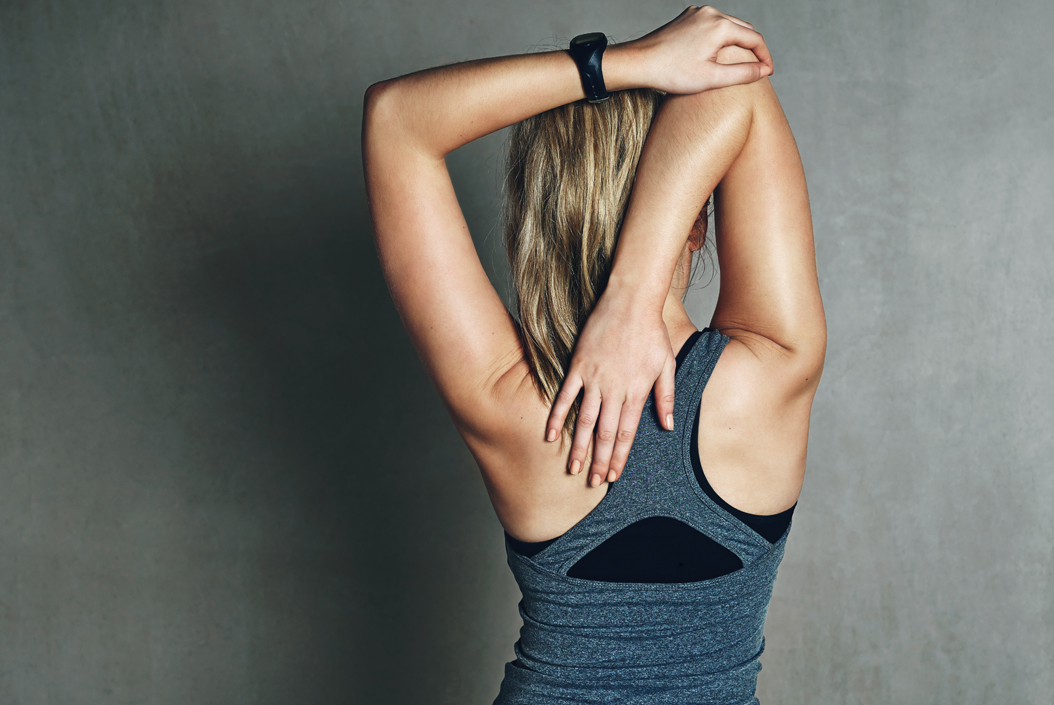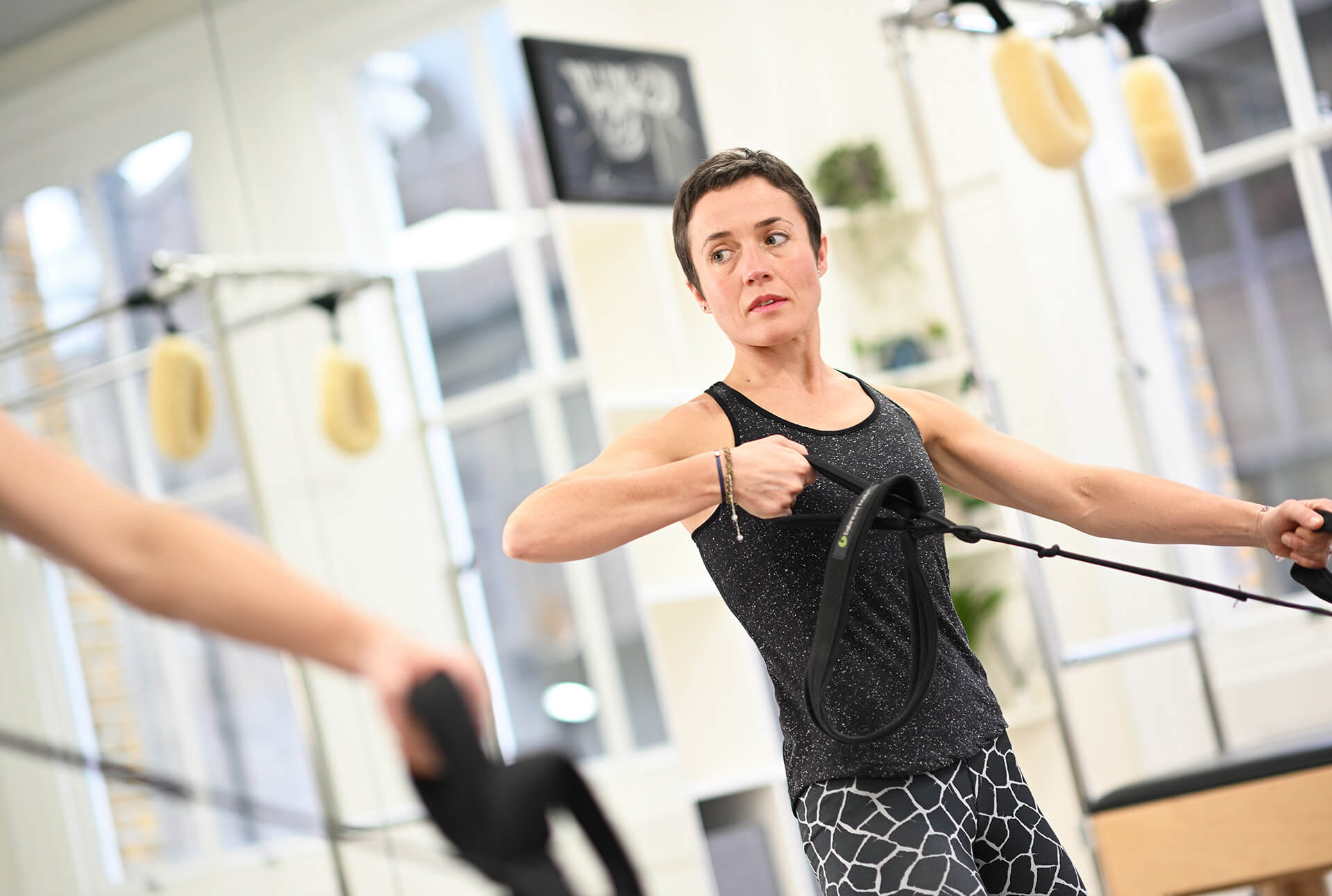“Pull your shoulders back and down”. “Anchor your shoulder blades down”. “Keep your shoulders away from your ears.” If you regularly attend Pilates classes then you’ll know these phrases well because they are all popular cues in Pilates.
And they’re all well-intentioned. They’re designed to correct postural issues that result from our modern lifestyles. Issues like a hunched upper body, tight chest and tense shoulders.
But the truth is, these instructions rarely produce the desired result. In fact, telling people to pull their shoulders down and back only creates more tension and restrictions.
We don’t want you to dismiss these corrections for no good reason, though. So here are the anatomical reasons why we should give these cues a miss – along with what you should do for your posture instead.
Shoulder blades – The technical bit:
Your shoulder blades are two bones that make up part of the shoulder girdle. This structure is attached to the muscles of the neck and rests on the rib cage.
The shoulder blades themselves are two flat, triangular bones that float on top of the rib cage. They attach to the upper arm bone (humerus) through a ball and socket joint.
Interestingly, the only “true” joint between the entire shoulder girdle, shoulder joint and the rest of the skeleton is where the collar bone joins the breast bone. This means that only muscles and ligaments hold each shoulder blade in place.
These factors are what allow the shoulder joint to be so mobile. It’s also what makes this area so vulnerable to injury.
What do the shoulder blades do?
The main functions of the shoulder blades include stabilising the arm and providing movement at the shoulder.
Of course, the latter doesn’t happen without support from the surrounding structures. In fact, the coordinated motion between the scapula and the head of the humerus is essential for movement. It’s so important there’s even a name for it: the scapulohumeral rhythm.
At the same time as facilitating movement, the scapula is also responsible for anchoring the arm to the trunk.
This is why dynamic stability of the scapula is needed. So, rather than fixing them in place by forcing them down, we need to be encouraging our shoulders to be stable yet still mobile.
Should I pull my shoulders back – The problems with forcing our shoulders back and down
Contracting any muscle all of the time is a bad idea. The same is true in this instance; there are negative side effects of constantly holding yourself in this way.
Firstly, keeping your shoulders in a fixed position is tiring! Doing so repeatedly makes muscles in the upper back tense and this creates pain and discomfort. Secondly, interfering in the normal function of the scapula disrupts the scapulohumeral rhythm. This then results in restricted movement at the shoulder joint.
For example, when the arms lift overhead the scapula need to be able to move freely around the ribcage. This is because they upwardly rotate to allow for this motion of the arms.
Keeping the shoulder blades down while the arms move up can prevent them from reaching that overhead position. This means that when the arms get to a certain point, the rest of the body has to compensate to achieve the action. Aside from being an inefficient way to move, over time this can lead to injuries.
Thirdly, pulling your shoulders back and down activates the muscles of the chest, back and shoulder. This restricts thoracic flexion – the rounding of the upper spine – which makes Pilates exercises like Roll Down impossible. Your shoulder blades need to move during this exercise to facilitate the rounding of the spine.
Finally, keeping your shoulders back and down repeatedly can leave you with depressed shoulders – shoulder fixed in that position –, which can cause longer-term movement restrictions.

Free your shoulder blades
Those with more serious problems – like depressed shoulder blades – should definitely seek the advice of a health care professional. For those that don’t, visiting a highly-qualified Pilates instructor can still be great idea. They can teach you how to properly execute exercises that involve movement at the shoulder. This will help protect your joints from wear and tear.
Related reading: Shoulder Exercises you can do at home
In the meantime, try this exercise to mobilise your scapula
- Starting position: Lie down on your back with your knees bent and hip-width apart. Arms down by your side.
- Next phase: Move your straight arms in an arc and stop when they are either side of your chest. Keep them here, separated the width of your body, with your palms facing each other.
- The exercise: Inhale to prepare. Exhale and allow your chest to soften as you reach the arms towards the ceiling. As you do so, your scapula will move around your ribcage. This is called scapula protraction.
- Next: On the exhale, bring your arms back towards you. Keep your arms straight and focus on bringing the scapula towards your spine at the back of your body. This is called scapula retraction.
- Repeat: Perform this protraction and retraction action several times.
Top Tips
In the retraction phase, avoid shrugging the shoulder blades by bringing them back and up. Instead, focus on the shoulder blades travelling directly backwards. Keep your neck relaxed throughout.
Imagery to help
Imagine your shoulder blades are bars of soap on a slippery surface. As you move, let them slide.
Imagine your shoulder blades are buoys on the surface of water. Let them float on the ribcage.
An alternative for your shoulders
As well as being helpful for this basic mobilisation drill, these images apply to most Pilates exercises.
Why not give them a go? Next time you’re in a class and are told to pull your shoulder blades down, use these images instead and let them glide. In the long term this will help to keep your shoulders healthy and pain-free.
If you want to talk about this more or are struggling with neck or shoulder pain, why not get in touch or book our new client offer today
Education is key:
These blogs are designed to give information to everyone, however, it is important to remember that everyone is different! If you have not seen one of our therapists and have any questions about injuries, what you have read or whether this may be useful to you, please just ask. We are more than happy to help anyone and point you in the right direction. Our biggest belief is that education is key. The more you understand about your injury, illness and movement, the more you are likely to improve.





